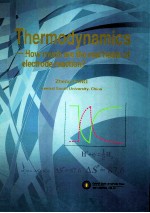

Thermodynamics-How much are the real heats of electrode reaction?PDF电子书下载
- 电子书积分:11 积分如何计算积分?
- 作 者:方正著
- 出 版 社:长沙:中南大学出版社
- 出版年份:2012
- ISBN:9787548707059
- 页数:295 页
Chapter 1 On Thermoelectrochemistry 1
1.1 Theory and Application of Thermoelectrochemistry 2
1.2 Some Basic Matters on the Heat Effects at Electrode-Electrolyte Interfaces 26
1.3 Thermoelectrochemistry and Its Application to Metallurgical Research 41
1.4 The Electrochemical Peltier Heat of the Standard Hydrogen Electrode Reaction 50
1.5 Response to"Comment on'The Electrochemical Peltier Heat of the Standard Hydrogen Electrode Reaction'by Zheng Fang et al" 62
1.6 Basic Equations for Thermo-electrochemistry and the Entropy Change of the Standard Hydrogen Electrode Reaction 71
1.7 The Peltier Heat and the Standard Electrode Potential of Ferroferricyanide Couple at 298.15K Determined by Electrochemicalcalorimetry 75
1.8 Determination of the Entropy Changes for Electrode Reaction and Dilute Enthalpy of Some Ions by Thermoelectrochemical Technology 88
References 93
Chapter 2 On Solution Chemistry 99
2.1 A New Model for Predicting Thermodynamic Properties of Ternary Metallic Solution from Binary Components 100
2.2 A Metallic Solution Model with Adjustable Parameter for Describing Ternary Thermodynamic Properties from Its Binary Constituents 110
2.3 A Model Describing the Osmotic Coefficients and the Activities of Water for Electrolyte Solutions 121
2.4 The Mean Activity Coefficients of LaCl3 in Dilute Aqueous Solution at 298.15 K 139
2.5 A Simplified Regular Solution Model for Solubility of Nonmetal(2)in Metal(1)-Metal(3)Alloy Systems 151
2.6 Modeling of Thermodynamic Properties of Multicomponent Electrolyte Solutions 159
2.7 A Simplified Subregular Solution Model Describing the Activites of MgCl2 in Both KCl-MgCl2-LiCl and CaCl2-MgCl2-NaCl Molten Salt Systems 167
2.8 A Model for the Activity Coefficients of Water in Aqueous Solution of HCl-MCln(M=Ni,Cu,Na,and Fe)with Constant Concentration Ratio XHCl/XMCln 173
2.9 A Prediction of the Excess Partial Molar Free Energies of MgCl2 in the KCl-MgCl2-LiCl Molten Salt System Containing MgCl2 below 0.5 from Thermodynamic Properties of Binary Systems 178
References 184
Chapter 3 On Phase Boundaries of Multicomponent System 187
3.1 Complete Integration of Gibbs-Duhem Equation along Phase Boundaries in Multicomponent System 188
3.2 Activities on Phase Boundaries in Multicomponent Systems—A Recursion Formula for Calculation of Activities 192
3.3 An Analogue Margules Equation on Phase Boundaries in Multicomponent Systems 201
References 208
Chapter 4 On Oxygen Potentials of Buffer Gases 209
4.1 Oxygen Potentials and Oxygen-potential Diagrams for Buffer Gas System at Normal Pressure 210
4.2 Effect of Oxygen Contents on Oxygen Potentials of H2O-H2 and H2O-H2-Inerts Gas Mixtures 222
4.3 Oxygen Potentials of CO2,H2O(g)and CO2-CO Gas Mixtures—with Extension of Application of Ellingham Diagram 234
References 248
Chapter 5 On Thermodynamic Properties of Substances 250
5.1 A Study on Thermodynamic Properties in the System MoO2-Mo by Gas Equilibration Method 251
5.2 Equilibria of the System MoO3-MoO2-H2O-H2 and Phase Diagram for the System Mo-O between 400 and 700℃ 262
5.3 Equilibrium between Non-stoichiometric MoO2 and Mo with Application of Sieverts'Law Constant to Smiltens'Integration 270
5.4 A New Molybdenum Oxide Phase 274
5.5 Recovery of Gallium from Coal Fly Ash 279
References 294
- 《中风偏瘫 脑萎缩 痴呆 最新治疗原则与方法》孙作东著 2004
- 《水面舰艇编队作战运筹分析》谭安胜著 2009
- 《王蒙文集 新版 35 评点《红楼梦》 上》王蒙著 2020
- 《TED说话的力量 世界优秀演讲者的口才秘诀》(坦桑)阿卡什·P.卡里亚著 2019
- 《燕堂夜话》蒋忠和著 2019
- 《经久》静水边著 2019
- 《魔法销售台词》(美)埃尔默·惠勒著 2019
- 《微表情密码》(波)卡西亚·韦佐夫斯基,(波)帕特里克·韦佐夫斯基著 2019
- 《看书琐记与作文秘诀》鲁迅著 2019
- 《酒国》莫言著 2019
- 《大学计算机实验指导及习题解答》曹成志,宋长龙 2019
- 《大学生心理健康与人生发展》王琳责任编辑;(中国)肖宇 2019
- 《大学英语四级考试全真试题 标准模拟 四级》汪开虎主编 2012
- 《大学英语教学的跨文化交际视角研究与创新发展》许丽云,刘枫,尚利明著 2020
- 《复旦大学新闻学院教授学术丛书 新闻实务随想录》刘海贵 2019
- 《大学英语综合教程 1》王佃春,骆敏主编 2015
- 《大学物理简明教程 下 第2版》施卫主编 2020
- 《大学化学实验》李爱勤,侯学会主编 2016
- 《中国十大出版家》王震,贺越明著 1991
- 《近代民营出版机构的英语函授教育 以“商务、中华、开明”函授学校为个案 1915年-1946年版》丁伟 2017
